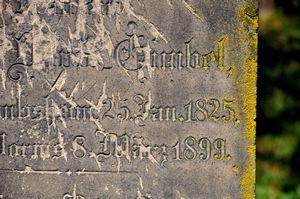Advertisement
Published: September 4th 2011

 Gravestone detail
Gravestone detail
Jewish Cemetery WormsWorms (pronounced as /voormz/, the -oo- in which being pronounced as in
door) is one of those towns in the Southwest of Germany, which, despite having a colourful, troubled history and a rich cultural heritage, suffer from a lack of attention by tourists domestic and foreign. A cynic would probably argue that it only appeals to tour groups comprised of elderly Germans or those showing a keen interest in the ecclesiastical, which might not even be too far from the truth. Indeed, the town feels rather antiquated, almost as if an invisible layer of dust clings on to everything, including the silver-haired locals. Churches abound wherever you look, there are seven in the historical centre alone. There is a half-arsed war memorial at the end of a pretty little park lane lined with flowers and bushes. It consists of five grim-looking, regretful stone soldiers, who appear to have lost all illusions, if they'd ever had any.
Outside of the centre, a worrying number of tanning salons, 1€-Shops, döner kebab-eateries, discount 'erotic'-stores and
Spielhallen, that dodgy German blend of casino, arcade and billiard hall, indicates that the town's economic situation might not be the best and that grand history has been
all but replaced by lowlife
Prekariat trash culture.
The cover of the map we get at the tourist office says 'Worms on the Rhine - It's worthwhile!', which sounds more like a desperate case of trying too hard than an invitation to visit. So why bother going in the first place? Well, maybe for Worms' Jewish heritage. In the late 10th century, a Jewish community was established, with the first synagogue erected in 1034. The community soon thrived, earning the town the moniker 'Little Jerusalem'. However, it was shattered in 1096, when 800 Jews were massacred by marauding crusaders on their way to the real Jerusalem. The final
Götterdämmerung for the Jews of Worms occurred during the
Reichskristallnacht in 1938, when Nazis desecrated and demolished the synagogue and destroyed much of the Jewish quarter.
These days, Worms has only a very small Jewish population, and no recognizable Jewish community to speak of. The Quarter and the synagogue may have been renovated, but they are now more of an outdoor museum than the living area of its designated inhabitants. Last year, the synagogue was firebombed by arsonists, but fortunately, no serious damage was done. The assailants left a note
in crude, grammatically and syntactically incorrect German, which translates to something like: "As soon as you don't give the Palestinians peace, we are not going to give you peace."
Then there is the association with Martin Luther. The recalcitrant priest had criticized the papal practice of selling 'indulgences' to exonerate sins and thus challenged the absolute authority of the Pope over the Church. He was subsequently ordered before the Imperial Diet of Worms, the general assembly of the Imperial Estates of the Holy Roman Empire, to recant his heretic views. Luther refused, allegedly uttering the now famous words "Here I stand. I can do no other", and was declared an outlaw.
If you're into classical music, you are most likely familiar with Wagner's
'Ring des Nibelungen', which is based on the
Nibelungenlied, an epic poem telling the rise and fall of the legendary kingdom of the Burgundians, set in its capital Worms. It is also the tale of Siegfried, the dragon slayer, and his wife Kriemhild, hence strolling around town, one inevitably encounters dragons as statues, reliefs and decorative elements.
The town's most famous landmark is its magnificent cathedral, built in the 11th and 12th centuries in
the late-Romanesque style. There is a lot to discover inside and outside the cathedral, including intricately carved statues, modernist church windows, a crypt with stone sarcophagi of several Holy Roman emperors. Our personal favourites were the statues depicting pious monks about to get raped by zealous beasts. Nothing beats the twisted fantasies of uptight, sexually repressed Christian freaks.
The most atmospheric and tranquil place one can find in Worms is the old Jewish Cemetery
Heiliger Sand (Holy Sands). Wandering amongst the simple, scattered gravestones and the more elaborate, crypt-like tombs with obelisks and broken columns, one feels 100 miles away from the forced historicity of the centre and the dinginess of the rest of the town. Just when you're enjoying yourself and the peaceful atmosphere of the vast cemetery, when you feel like you can actually breathe for once, the sight of the attempted scratching away at the inscriptions of several gravestones, probably by the real Nazis back in the day or by try hard, wannabe neo-Nazis, manages to put a damper on the mood, which always seems to be achieved all too easily in this country.
Advertisement
Tot: 0.104s; Tpl: 0.014s; cc: 12; qc: 29; dbt: 0.0479s; 1; m:domysql w:travelblog (10.17.0.13); sld: 2;
; mem: 1.1mb

























j-dog
non-member comment
die sun
ihr grien gräbs un ich näd!